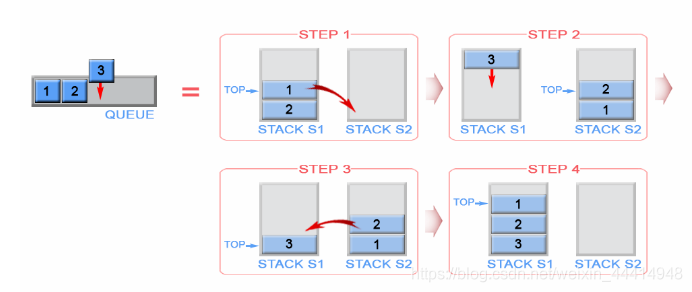题目:
232、用栈实现队列
请你仅使用两个栈实现先入先出队列。队列应当支持一般队列的支持的所有操作(push、pop、peek、empty):
实现 MyQueue 类:
void push(int x) 将元素 x 推到队列的末尾
int pop() 从队列的开头移除并返回元素
int peek() 返回队列开头的元素
boolean empty() 如果队列为空,返回 true ;否则,返回 false
说明:
你只能使用标准的栈操作 —— 也就是只有 push to top, peek/pop from top, size, 和 is empty 操作是合法的。
你所使用的语言也许不支持栈。你可以使用 list 或者 deque(双端队列)来模拟一个栈,只要是标准的栈操作即可。
进阶:
你能否实现每个操作均摊时间复杂度为 O(1) 的队列?换句话说,执行 n 个操作的总时间复杂度为 O(n) ,即使其中一个操作可能花费较长时间。
示例:
输入:
[“MyQueue”, “push”, “push”, “peek”, “pop”, “empty”]
[[], [1], [2], [], [], []]
输出:
[null, null, null, 1, 1, false]
解释:
MyQueue myQueue = new MyQueue();
myQueue.push(1); // queue is: [1]
myQueue.push(2); // queue is: [1, 2] (leftmost is front of the queue)
myQueue.peek(); // return 1
myQueue.pop(); // return 1, queue is [2]
myQueue.empty(); // return false
提示:
1 <= x <= 9
最多调用 100 次 push、pop、peek 和 empty
假设所有操作都是有效的 (例如,一个空的队列不会调用 pop 或者 peek 操作)
题解思路:
队列是一种 先进先出(first in - first out, FIFO)的数据结构,队列中的元素都从后端(rear)入队(push),从前端(front)出队(pop)。
栈是一种 后进先出(last in - first out, LIFO)的数据结构,栈中元素从栈顶(top)压入(push),也从栈顶弹出(pop)。
为了满足队列的 FIFO 的特性,我们需要用到两个栈,用它们其中一个来反转元素的入队顺序,用另一个来存储元素的最终顺序。
入队(push)
一个队列是 FIFO 的,但一个栈是 LIFO 的。这就意味着最新压入的元素必须得放在栈底。为了实现这个目的,我们首先需要把 s1 中所有的元素移到 s2 中,接着把新元素压入 s1。最后把 s2 中所有的元素弹出,再把弹出的元素压入 s1。

出队(pop)
直接从 s1 弹出就可以了,因为 s1 的栈顶元素就是队列的队首元素。同时我们把弹出之后 s1 的栈顶元素赋值给代表队首元素的 front 变量。

题解python代码:
class MyQueue:
def __init__(self):
"""
Initialize your data structure here.
"""
self.A = []
self.B = []
self.front = None
def push(self, x: int) -> None:
"""
Push element x to the back of queue.
"""
while self.A:
self.B.append(self.A.pop())
self.A.append(x)
while self.B:
self.A.append(self.B.pop())
self.front = self.A[-1]
def pop(self) -> int:
"""
Removes the element from in front of queue and returns that element.
"""
t = self.A.pop()
if self.A: self.front = self.A[-1]
else: self.front = None
return t
def peek(self) -> int:
"""
Get the front element.
"""
return self.front
def empty(self) -> bool:
"""
Returns whether the queue is empty.
"""
return not self.A
# Your MyQueue object will be instantiated and called as such:
# obj = MyQueue()
# obj.push(x)
# param_2 = obj.pop()
# param_3 = obj.peek()
# param_4 = obj.empty()

作者:a-qing-ge
链接:https://leetcode-cn.com/problems/implement-queue-using-stacks/solution/guan-fang-ti-jie-fang-fa-yi-pythonban-by-95l6/
来源:力扣(LeetCode)https://leetcode-cn.com/problems/implement-queue-using-stacks/